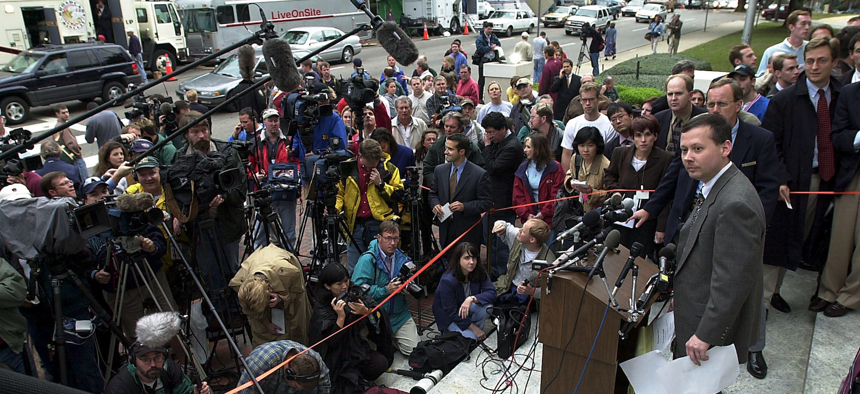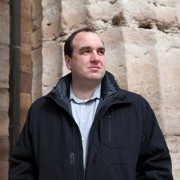Politics
No longer above the fray, state supreme courts pulled into overtly political conflicts
The courts have become top-tier targets for party leaders, often considered the key to unlocking control of state legislatures, gubernatorial mansions and even Congress.

One of the best known intersections of law and politics was in 2000 in Florida. Craig Waters, at the lectern, then the public information officer for the Florida Supreme Court, announces on Nov. 17, 2000, in Tallahassee that the Supreme Court barred Florida Secretary of State Katherine Harris from certifying "until further order" the results of the US presidential election in the state. Photo by JEFF KOWALSKY/AFP via Getty Images
State supreme courts have never been free of politics. Look at Florida in 2000.
But not too long ago, they were viewed as second-tier prizes among political operatives, mostly the province of trial lawyers and chambers of commerce. Now, though, those courts have emerged as a top-tier target for party leaders, often considered the key to unlocking control of state legislatures, gubernatorial mansions and even Congress.
Perhaps the most blatant recent example of the change has been in Wisconsin, where Assembly Speaker Robin Vos, a Republican, has threatened to impeach a brand new Supreme Court justice depending on how she rules on a redistricting lawsuit.
Wisconsin’s Republican-drawn map for state legislative districts has given the GOP an outsize advantage in keeping control of the legislature, even as Democrats win most statewide races. Redrawing the maps could jeopardize Republicans’ control of the legislature, which they have used to stymie liberal policies and curb the power of Democratic Gov. Tony Evers. The Wisconsin Supreme Court chose the Republican plan in 2022, after the U.S. Supreme Court rejected an alternative proposed by Evers.
But Wisconsin Democrats challenged the GOP maps again in August, days after Justice Janet Protasiewicz was sworn in and liberals gained a 4-3 majority on the nominally nonpartisan court. During the campaign, Protasiewicz called the Republican maps “rigged” and “unfair.”
Vos and other Republican leaders have raised the prospect of impeaching Protasiewicz, because she did not recuse herself from the redistricting case. The Assembly speaker consulted with several retired high court judges who advised him not to pursue impeachment. But Vos this week said the legislature could still impeach Protasiewicz, depending on how she ruled on the redistricting lawsuit.
“She has said she can be an independent jurist,” Vos said. “If we see that the contributions that the Democratic Party made to her expecting a result [a ruling in their favor on the redistricting case], that will certainly be something that we have to keep on the table because she will not live up to her oath.”
In Florida, Republican Gov. and now presidential candidate Ron DeSantis began reshaping the state's highest court after a trio of liberal-leaning justices retired at the same time in 2019. DeSantis now has appointed five of the court's current seven justices, six of whom lean reliably to the right on hot-button issues. The seventh, Jorge Labarga, has been described by Bloomberg Law as “stand(ing) out (because) his allies describe him as a throwback to a bygone era of centrism and compromise.”
Other states have shown how a switch in control of the supreme courts can shape the local political landscape:
— In April, the North Carolina Supreme Court overturned a previous ruling that would have made the legislature redraw its districts. The court flipped from a Democratic majority to Republican control just a few months earlier. As a result, GOP lawmakers could keep their existing maps. (Last month, Democratic Gov. Roy Cooper appointed Allison Riggs, who had worked as an election law attorney to block Republican redistricting plans, to the high court.)
— In New York, Democrats hoped a new member of the state’s top court, the Court of Appeals, could mean new hope for their bid to redraw the state’s congressional maps. The author of the decision to uphold those maps retired. But her replacement, Judge Caitlin Halligan, announced Friday she would recuse herself from the high-profile case because of personal conflict of interest. An appeals court judge will replace her on the case, adding another level of uncertainty that could affect the partisan balance of the narrowly divided U.S. House.
Michael Nelson, a Penn State political science professor who studies state supreme courts, said state high courts have been increasingly drawn into overtly political conflicts. The U.S. Supreme Court’s decision to overturn Roe v. Wade means many state high courts, including Florida, will determine abortion policy. Plus, the 2020 presidential race and fights over COVID-19 policies often led to fights before state supreme courts.
But the transformation has been decades in the making, he said. Voters kicked three members of the Iowa Supreme Court off the bench in 2009, after the high court unanimously approved same-sex marriage in the state. In 2018, the West Virginia House of Delegates impeached the entire state supreme court, although courts effectively stopped the impeachment trials.
In fact, Karl Rove, President George W. Bush’s political advisor, “came to prominence as a political operative in the South by realizing that it’s a lot cheaper to flip three or four seats on a state supreme court than to have to flip 20 or 30 seats in a state legislature, but both institutions have a lot of policy power,” Nelson said. “Ever since then, these elections have been steadily increasing in prominence.”
But Rove’s campaigns in places like Alabama and Texas focused on installing business-friendly conservatives on high courts at a time when Democrats controlled state governments there. The ads often attacked judges for their handling of criminal cases, implying that they were too lenient.
These days, though, the campaigns are more straightforward, as candidates and their ads discuss hot-button issues likely to come before the court, such as redistricting, COVID-19 policies and abortion, Nelson said.
Even in states where supreme court fights don’t make front-page news, lawmakers have changed the process by which those judges are chosen, Nelson said. In Iowa, for example, Gov. Kim Reynolds gained more power in picking judges, and, as a result, the high court reversed course on whether the state constitution included a right to an abortion.
“They’ve made a lot of incremental changes,” Nelson said. “Those are hard issues that people don’t pay attention to, and they’re not super transparent for journalists to cover and understand. But those are the kinds of things that, over the long term, are really going to change the composition of these courts.”
The increased partisanship on supreme courts could affect which kinds of people are even interested in serving in those roles, he added. It could be less attractive for a highly paid lawyer to seek a judgeship, if it means a pay cut, intense media coverage and deciding hot-button issues that are likely to upset half the state.
That’s a far different prospect than in the past, when lawyers figured they might get some scrutiny during the campaign, but then settle into a job of determining Fourth Amendment rules for dog sniffs of vehicles or interpreting obscure statutes. “It means that the sort of people who want to be judges are people who are much more political,” Nelson said.
For the public, the political tug-of-war over control of the courts could reverberate far beyond the partisan fights, especially as new majorities feel empowered to overturn prior decisions.
“That sort of instability has a lot of consequences,” he said. “Businesses rely on the stability of law when deciding what contracts they’re going to make. Police officers rely on the stability of law to determine what an appropriate search is when they’re pulling people over for traffic stops. There are really wide-ranging consequences for that lack of predictability.”
Jim Rosica contributed. A version of this story was first published on Route Fifty.
NEXT STORY: So who’s going to be the next governor of Florida?
